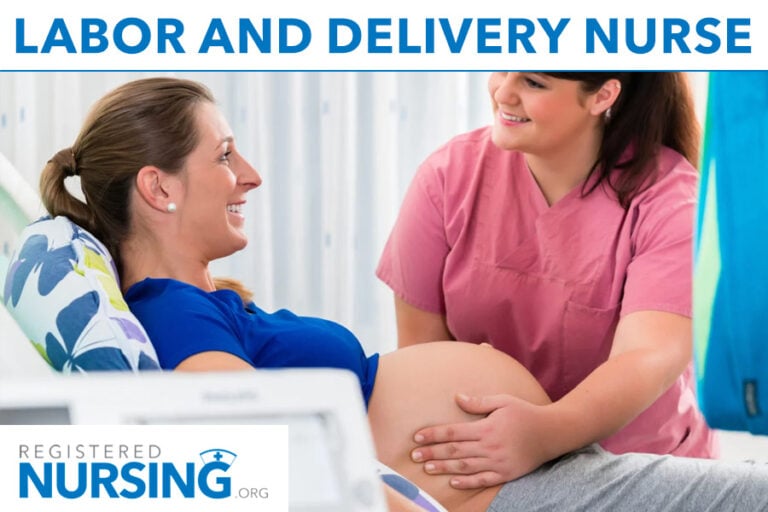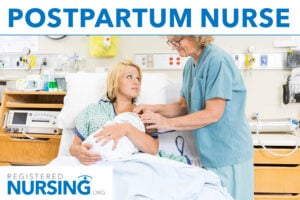What is a Labor and Delivery Nurse?
One only needs to look at population statistics to note that a mother’s labor and delivery of an infant is one of the most common medical experiences to have. With that in mind, it’s important to recognize that each woman’s experience is unique, and has its own potential pitfalls as the patient and healthcare teamwork to bring a new life into the world. Labor and Delivery (or L&D) nurses are known for their calm and practical demeanor as they work with women of all ages and health outcomes to ensure everyone manages the birth with appropriate comfort measures and safety precautions.
Labor and delivery nurses are one of many types of nurses who work primarily with families and babies, and as a result, they sometimes get confused with other roles. Here are some other delivery-oriented nurses and their differences:
| Type of Nurse | Role | Education / Licensure / Certifications |
| Certified Nurse Midwife (CNM) | Provides prenatal care, delivers babies, postpartum care | RN, Master’s degree, CNM certification |
| Obstetric Nurse | Assists with prenatal care and educates mothers | RN, Inpatient Obstetric Nursing (RNC-OB) certification |
| Postpartum Nurse | Cares for mothers and newborns after delivery | RN, Basic Life Support (BLS), NRP certification |
| NICU (Neonatal) Nurse | Cares for premature and sick newborns | RN, Neonatal Intensive Care Nursing (RNC-NIC) certification |
| Nurse Practitioner | Provides comprehensive care and manages health conditions | RN, Master’s or Doctorate degree, NP certification |
| Clinical Nurse Specialist (CNS) | Provides specialized care, often in neonatal or perinatal care | RN, Master’s or Doctorate degree, CNS certification |
| Perinatal Nurse | Cares for women through pregnancy, labor, and postpartum | RN, BLS, Advanced Life Support in Obstetrics (ALSO) certification |
How to Become a Labor and Delivery Nurse
Labor and delivery nurses have the complex job of advocating for both the mother and her yet-to-be-born baby, which means that they require a finely honed set of ethics and a deep understanding of the relationship between the two patients. L&D nurses remain calm when patient tensions run high and discomfort mounts and often engage family members and spouses in how to bring comfort to their laboring partners. Nurses in this field take their responsibility for patient mental and emotional health seriously, as becoming a mother shifts the foundation upon which future relationships depend.
What Are the Schooling Requirements for a Labor and Delivery Nurse?
Not to be confused with a midwife or a doula, the Labor and Delivery nurse requires a degree from an accredited ADN or BSN program – a Bachelor’s of Science in Nursing is considered highly competitive for job application. Every nurse must pass the state’s NCLEX-RN examination for licensure in order to be considered fully licensed RN. L&D nurses often have a strong interest in obstetrics and gynecology, and view themselves as strong advocates of mothers and their children in the healthcare setting.
Experienced nurses need at least one year of bedside nursing experience and are often required to work as Postpartum Nurses prior to transitioning into the L&D role.
Any Certifications or Credentials Needed?
In addition to experience as a postpartum nurse, Labor and Delivery nurses require certification in Basic Life Support (BLS) and Advanced Cardiac Life Support (ACLS). At present, field-specific continuing education and certification programs that are offered for Labor and Delivery are through the National Certification Corporation (NCC), which cover the stages of labor in depth, best practices for Caesarian section birth, best practices in labor and delivery for various segments of the population, as well as anesthetics and pharmacology. Most hospitals typically require the Inpatient Obstetric Nursing (RNC-OB) certification after a set period of employment. To be eligible to take the RNC-OB exam, the RN must have 24 months of experience in the field.
What Does a Labor and Delivery Nurse Do?
Working closely with the obstetricians and gynecologists in the ward, L&D nurses work in a hospital setting with other support staff to ensure that mothers and their birth team have a safe experience both laboring and delivering babies.
Working with a low patient ratio, some Labor and Delivery nurses work in the general ward, while others choose to specialize in working with high-risk groups – mothers with high-risk pregnancies, advanced maternal age, or those having issues with fetal development. High-risk L&D facilities are more common in teaching hospitals and urban areas.”
Where Do Labor and Delivery Nurses Work?
Labor and Delivery nursing is by no means a niche role given how common medical intervention is for birthing throughout the world. Nurses work in hospitals, birthing centers and as community resources. Senior nurses may opt to specialize further in this type of care and support, augmenting their training and experience to study issues like lactation and healthy birth and maternal outcomes in the community.
What Are the Roles & Duties of a Labor and Delivery Nurse?
- Provides direct patient care in the maternal specialty area to both mother and infant
- Evaluates patient care and plans according to best patient outcomes and facility resources.
- Monitors, documents, and communicates mother, fetal and infant status to members of the interdisciplinary team.
- Coordinates maternal patient care holistically, advocating for physical, emotional and psycho-social needs.
- Evaluates learning needs of patient and partners, and provides education appropriate to circumstances.
- Refers patient(s) care to ancillary support staff and specialists
- Acts as preceptor or mentor to student nurses, support staff and new hires.
- Adept at interpreting fetal heart monitoring and EKG readings
- Provides appropriate nursing care for childbearing women from teens to advanced maternal age
- Provides advocacy, education and care from pregnancy through to postpartum phases, including fetal and infant care
- Advocates for room-in or single-room, family centered care philosophy
Labor and Delivery Nurse Salary & Employment
The average salary of the L&D RN is $81,800, with a range of $67,663 – $102,433. Location, experience, certifications, and experience affect salary. Jobs are forecasted to continue to grow in this field, as our population, and indeed the world's population, continue to grow.
| Average Yearly Salary | |
| Lowest Earners | $67,663 |
| Lowest 25% | $74,400 |
| Median | $81,800 |
| Top 25% | $92,600 |
| Top Earners | $102,433 |
Helpful Organizations, Societies, and Agencies
- American Association of Critical-Care Nurses
- American Journal of Critical Care
- Critical Care Nurse
- Advanced Critical Care
- Intensive and Critical Care Nursing
- The British Association of Critical Care Nurses
- Canadian Association of Critical Care Nurses









